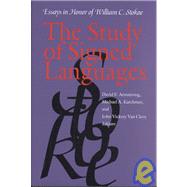
Note: Supplemental materials are not guaranteed with Rental or Used book purchases.
Purchase Benefits
Looking to rent a book? Rent The Study of Signed Languages [ISBN: 9781563681233] for the semester, quarter, and short term or search our site for other textbooks by Armstrong, David F.; Karchmer, Michael A.; Van Cleve, John Vickrey; Karchmer, Michael A.; Stokoe, William C.. Renting a textbook can save you up to 90% from the cost of buying.
| List of Contributors | p. viii |
| Preface: William C. Stokoe and the Study of Signed Languages | p. xi |
| Introduction: Bill Stokoe: An ASL Trailblazer | p. 1 |
| Historical Perspectives | |
| Introduction | p. 9 |
| The Curious Death of Sign Language Studies in the Nineteenth Century | p. 13 |
| Historical Observations on the Relationship Between Research on Sign Languages and Language Origins Theory | p. 35 |
| Modality Effects and Conflicting Agendas | p. 53 |
| Language Origins | |
| Introduction | p. 85 |
| Does Sign Language Solve the Chomsky Problem? | p. 89 |
| Continuity, Ethology, and Stokoe: How to Build a Better Language Model | p. 100 |
| William C. Stokoe and the Gestural Theory of Language Origins | p. 118 |
| Diverse Populations | |
| Introduction | p. 133 |
| The Impact of Variation Research on Deaf Communities | p. 137 |
| The Impact of Sign Language Research on Black Deaf Communities in America | p. 161 |
| Bilingualism and the Impact of Sign Language Research on Deaf Education | p. 172 |
| Sign Communication Training and Motor Functioning in Children with Autistic Disorder and in Other Populations | p. 190 |
| Gesture and the Nature of Language in Infancy: The Role of Gesture as a Transitional Device En Route to Two-Word Speech | p. 213 |
| Concluding Thoughts: The Future of American Sign Language | p. 247 |
| Index | p. 263 |
| Table of Contents provided by Syndetics. All Rights Reserved. |
The New copy of this book will include any supplemental materials advertised. Please check the title of the book to determine if it should include any access cards, study guides, lab manuals, CDs, etc.
The Used, Rental and eBook copies of this book are not guaranteed to include any supplemental materials. Typically, only the book itself is included. This is true even if the title states it includes any access cards, study guides, lab manuals, CDs, etc.